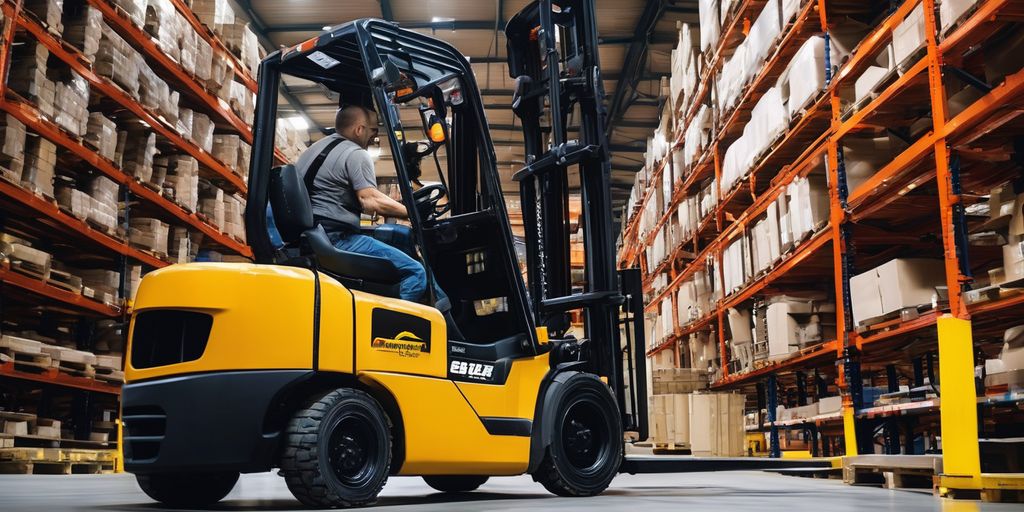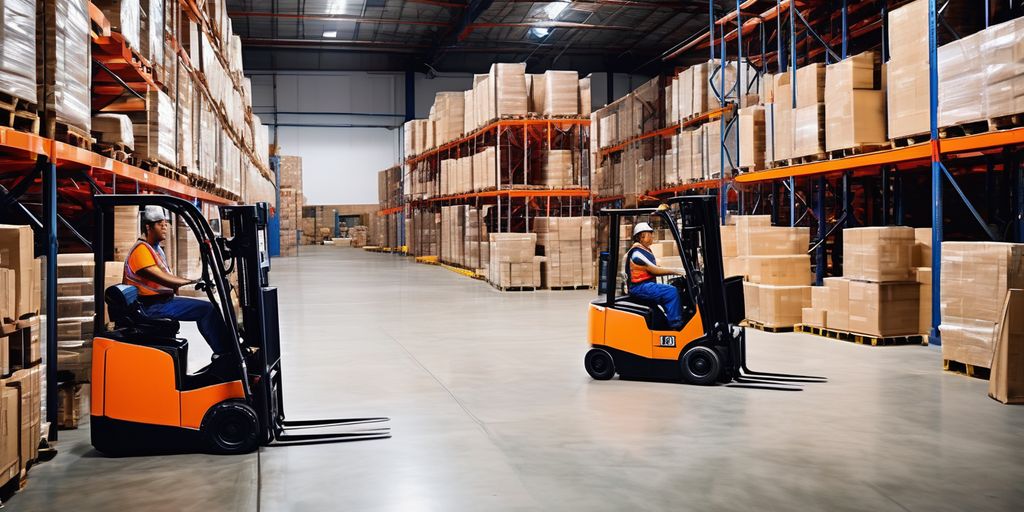Understanding Forklift Load Capacity: Tips for Safe Operations — overview
Understanding forklift load capacity is crucial for ensuring safe and efficient operations in any workplace that utilizes these powerful machines. An in-depth knowledge of how much weight a forklift can safely carry, how this capacity can vary between different models, and how to properly manage loads can significantly reduce the risk of accidents and improve operational productivity. This article provides essential tips and insights into forklift load capacity to help foster a secure and efficient working environment.
Key Takeaways
- Always adhere to the specified load capacities on the forklift’s capacity plate to prevent accidents and equipment damage.
- Regular training and certification for operators is vital to ensure they understand load management and safety protocols.
- Proper maintenance and regular inspections are necessary to ensure that the forklift is capable of handling the designated loads safely.
- Understanding the different types of forklifts and their specific load capacities can optimize the efficiency and safety of operations.
- Invest in technology and continuous learning to keep up with advancements in forklift design and load capacity management.
Understanding Forklift Load Capacity Basics

Determining Safe Load Capacities
Knowing the weight and size limitations of a given forklift is crucial for maximizing efficiency and safety. Operators must consider the forklift's capacity to ensure they are not exceeding its limits, which can lead to accidents and reduce the lifespan of the equipment.
Reading and Using Capacity Plates
Capacity plates provide essential information about a forklift's capabilities, including maximum load and the optimal load center. It's vital for operators to understand and adhere to these specifications to maintain safe operations.
Importance of Operator Manuals
Operator manuals are key resources that provide detailed guidance on handling and operating a forklift safely. They include best practices for operating a forklift, ensuring that all necessary precautions are taken for efficient and safe use of the vehicle.
Types of Forklifts and Their Capacities

Electric and Diesel/LPG Forklifts
Electric forklifts are known for their efficiency and are suitable for indoor use due to zero emissions. Diesel and LPG forklifts, on the other hand, are preferred for outdoor or rough terrain applications due to their power and durability. Key considerations when buying a forklift include assessing the environment and load types.
Specialized Forklifts: Rough Terrain and Side Loaders
Specialized forklifts like rough terrain and side loaders are designed to operate in challenging environments. Rough terrain forklifts have higher ground clearance and robust tires, making them ideal for construction sites or uneven surfaces. Side loaders are effective in handling long or bulky loads, enhancing maneuverability in tight spaces.
Capacity Variations Across Different Models
Forklift capacities can vary significantly across different models and types. For instance, electric 3-wheelers typically range from 3,000 lb. to 5,000 lb., while internal combustion counterbalance forklifts can handle up to 158,500 lb. It's crucial to choose the right forklift by considering load capacity, lift height, and fuel type to ensure efficient and safe operations.
Safety Concerns Related to Exceeding Load Capacity

Risks of Overloading
Exceeding the specified load capacity of a forklift can lead to several serious safety hazards. These risks include tipping over, dropping the load, and loss of steering control, which can result in injuries or even fatalities. Ensuring that operators adhere to the designated load capacities is crucial for maintaining a safe work environment.
Recognizing Load Capacity Signs
Operators must be vigilant in recognizing the signs that indicate when a load is potentially too heavy. This includes understanding the capacity plate information and being aware of the forklift's performance during operation. If a forklift begins to show signs of strain, it may be an indication that the load is too heavy.
Training and Certification Importance
Proper training and certification in forklift operation are essential for safety. Operators should be trained on the specific models they will be using and understand the unique load capacities for each. Regular training updates and recertifications ensure that safety practices are up-to-date and top of mind.
Optimizing Load Distribution for Safe Operations

Balancing Loads
Balancing loads is crucial for maintaining stability and preventing accidents. Operators should ensure that the weight is evenly distributed across the forks and that the load center complies with manufacturer specifications. This practice not only enhances safety but also improves the forklift's efficiency.
Handling Uneven or Unstable Loads
Handling uneven or unstable loads requires careful attention to detail and adherence to safety protocols. Operators should use stabilizing equipment and adjust their driving according to the load's stability. This might include reducing speed and avoiding sudden movements to maintain control.
Strategic Stacking Techniques
Effective stacking techniques are essential for optimizing space and ensuring stability. Operators should follow a systematic approach:
- Place heavier items on the bottom.
- Stack lighter items on top.
- Ensure that each layer is stable before adding another.
- Check for any overhangs and adjust accordingly.
By adhering to these principles, operators can significantly reduce the risk of accidents and increase operational efficiency.
Maintenance and Inspection for Load Capacity Assurance

Regular Maintenance Checks
[Regular maintenance checks](https://www.nwforklift.com/post/top-forklift-maintenance-best-practices-for-safety-and-efficiency) are crucial to ensure that forklifts operate safely and efficiently. Implement a maintenance schedule that includes inspections of brakes, steering, controls, and lifting components. This will help identify any potential issues that could affect load capacity and overall safety.
Inspection Before Use
Before operating a forklift, it's essential to perform a pre-use inspection. Check for signs of wear and tear, fluid leaks, or loose parts that could compromise the forklift's functionality. This routine check helps prevent accidents and maintains the forklift's load capacity.
Updating Capacity Plates as Needed
Capacity plates should be updated whenever modifications are made to a forklift that could change its load capacity. This includes changes in attachments or significant repairs. Keeping the capacity plate updated ensures that all operators are aware of the current capabilities and limitations of the forklift.
Investing in Operator Training and Safety Culture

Benefits of Certified Operators
Certified operators are crucial for maintaining a safe and efficient workplace. They possess a deep understanding of safety protocols, equipment functionality, and load capacity considerations. This knowledge not only enhances the safety of operations but also boosts overall productivity.
Creating a Culture of Safety
A culture of safety is built through continuous efforts and commitment at all levels of an organization. It involves regular training sessions, adherence to safety protocols, and a proactive approach to hazard identification and risk management. Collaborative training initiatives play a key role in fostering this culture, encouraging the exchange of knowledge and best practices among team members.
Continuous Learning and Improvement
The journey towards safety excellence is ongoing. It involves regular updates to training programs, staying informed about the latest safety regulations, and integrating new technologies that enhance safety and efficiency. Continuous learning and improvement ensure that safety practices remain effective and relevant, adapting to new challenges and changes in the workplace.
Compliance with Regulations and Manufacturer Guidelines

Ensuring compliance with both government regulations and manufacturer guidelines is crucial for maintaining safety and efficiency in forklift operations. Adhering to these standards not only helps in avoiding legal penalties but also enhances the operational capabilities of the equipment.
Following Government Regulations
Compliance with government regulations such as OSHA's safety training guidelines is essential. These regulations are designed to ensure that forklift operations are carried out safely and effectively. Operators must be aware of and adhere to these standards to maintain a safe working environment.
Adhering to Manufacturer's Instructions
Manufacturers provide detailed guidelines specific to each forklift model, including load capacity and operational instructions. It is imperative for operators to familiarize themselves with these guidelines to ensure the forklift is used within its safe operational parameters.
Documentation and Record Keeping
Keeping detailed records of maintenance, inspections, and training is vital for compliance. These documents not only serve as proof of adherence to regulations but also help in identifying potential issues before they lead to accidents or equipment failure.
Technological Advancements in Load Capacity Management

Innovations in Forklift Design
The forklift industry has seen significant innovations in design that enhance both safety and operational efficiency. Features like improved ergonomics, increased fuel efficiency, and enhanced maneuverability are now standard in newer models. These advancements not only make forklifts more comfortable to operate but also more adaptable to various working environments.
Smart Systems for Load Management
Integration of smart systems into forklifts has revolutionized how load management is approached. Systems equipped with sensors and data analytics provide real-time feedback on load stability and weight distribution, ensuring that operators are aware of potential safety issues before they escalate. This proactive approach to load management is crucial for maintaining high safety standards in material handling operations.
Impact of Technology on Safety and Efficiency
The integration of technology into forklift operations has had a profound impact on both safety and efficiency. Technologies such as IoT and telematics allow for real-time monitoring and data-driven decision-making, which significantly reduces the risks associated with material handling. By leveraging these technologies, businesses can achieve higher productivity while ensuring the safety of their operators and infrastructure.
Conclusion
In conclusion, understanding and adhering to a forklift's load capacity is paramount for ensuring safety and efficiency in operations. By following the guidelines outlined in this article, such as inspecting loads, using appropriate attachments, and maintaining balanced load distribution, operators can minimize the risk of accidents and extend the lifespan of their equipment. It is essential to prioritize safety, invest in thorough training, and adhere to the manufacturer's guidelines to foster a secure working environment. Remember, a well-informed operator is key to maximizing productivity and maintaining safety standards in any material handling scenario.
Frequently Asked Questions
What is forklift load capacity and why is it important?
Forklift load capacity refers to the maximum weight a forklift can safely carry. It's crucial for ensuring safe operations, preventing accidents, and maintaining the equipment's longevity by avoiding overloading.
How can I determine a forklift's safe load capacity?
The safe load capacity can be determined by consulting the forklift's capacity plate, which includes vital information such as weight limits and load center. Always ensure the plate is legible and up-to-date.
What are the risks of exceeding a forklift's load capacity?
Exceeding the load capacity can lead to forklift instability, increasing the risk of tipping and accidents, potentially causing injuries or damage to goods and equipment.
Why is operator training important for managing load capacity?
Proper training ensures operators are aware of load capacity limits, can interpret capacity plates correctly, and follow safe loading practices, thereby enhancing overall workplace safety.
How does maintaining a forklift affect its load capacity?
Regular maintenance ensures the forklift operates at optimal conditions, which helps preserve its designated load capacity. Neglecting maintenance can lead to mechanical failures that compromise load capacity.
What should be done if the load capacity plate is unreadable or missing?
If the load capacity plate is unreadable or missing, it should be replaced immediately. Operating a forklift without this information is unsafe and can lead to serious accidents.




Leave a comment
This site is protected by hCaptcha and the hCaptcha Privacy Policy and Terms of Service apply.